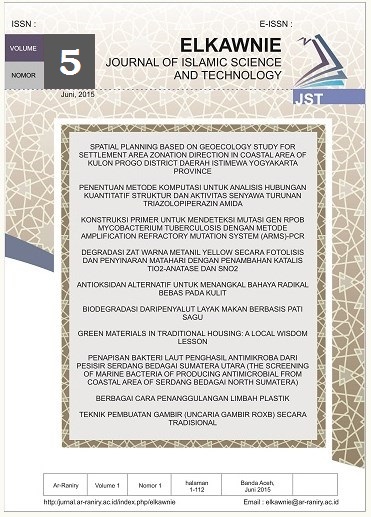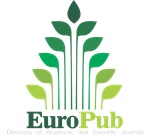The UV-Vis Study On Anthocyanin Pigments Activities Extracted From Gayo Arabika Coffee Husks
DOI:
https://doi.org/10.22373/ekw.v5i2.5232Keywords:
anthocyanin, coffee husks, Uv-vis studyAbstract
The anthocyanin activity of Gayo Arabica coffee husk in variations in acid solution, temperature, and pH has been assessed through UV-Vis studies. It is important to optimize these factors to increase the long-term stability of anthocyanins for use in various fields. Gayo Arabica coffee husks was extracted through maceration method with methanol. This process obtained a coffee husks extract of 1.176 mg/μL. The UV-Vis spectrum of the extract displayed the major absorption peak at λmax= 529 nm in hydrochloric acid (HCl), this assigned by the electronic transition from flavylium as the particular characteristic of anthocyanin compounds. The anthocyanin from the extract was stable at temperatures of 35oC and 50oC, to have a major absorption peak at λmax= 529 nm. Therefore, it could probably be said that the lower the temperature, the higher the absorbance value of anthocyanin. Then, husks extract was getting red at pH 1 and 3; almost colorless at pH 5, 8 and 10; and yellow at pH 12. The more acidic conditions causes more anthocyanin pigments to be observed in the form of flavylium or oxonium cations color. Finally, Gayo Arabica coffee husks extract can absorb both ultraviolet (UV) and visible light (visible).References
Aal, E. S. S. M. A., Hucl, P., & Rabalski, I. 2018. Compositional and Antioxidant Properties of Anthocyanin-rich Products Prepared from Purple Wheat. Food Chem, 254, 13-19. https://doi.org/10.1016/j.foodchem.2018.01.170
Abdel-Aty, A. M., Salama, W. H., Fahmy, A. S., & Mohamed, S. A. 2018. Impact of Germination on Antioxidant Capacity of Garden Cress: Newcalculation for Determination of Total Antioxidant Activity. Scientia Horticulturae, 246 (27), 155-160. https://doi.org/10.1016/j.scienta.2018.10.062
Abugri, D.A., Apea, O.B. and Pritchett, G.. 2012. Investigation of a Simple and Cheap Source of a Natural Indicator for Acid-Base Titration: Effects of System Conditions on Natural Indicators. Green and Sustainable Chemistry, 2, 117-122. http://dx.doi.org/10.4236/gsc.2012.23017
Ariadi, H., R. 2015. Ekstraksi Senyawa Antioksidan Kulit Buah Kopi: Kajian Jenis Kopi dan Lama Maserasi. Berkala Ilmiah Pertanian. 1 (1). http://repository.unej.ac.id/handle/123456789/72852
Bueno, J.M., Plaza, P.S., Escudero, F.R., Jimenez, A.M., Fett, R. & Asuero, A.G.. 2012. Analysis and Antioxidant Capacity of Anthocyanin Pigments. Part II: Chemical Structure, Color, and Intake of Anthocyanins. Critical Review in Analytical Chemistry, 42 (2): 126-151. http://dx.doi.org/10.1080/10408347.2011.632314
Chen, G. L. Fan, M. X., Wu, J. L., Li, N., & Guo, M. Q. 2018. Antioxidant and Anti Inflammatory Properties of Flavonoids from Lotus Plumule. Food Chemistry, 277 (30), 706-712. https://doi.org/10.1016/j.foodchem.2018.11.040
Faria, A.F., Marcella, C.M. and Adriana, Z.M. 2011. Identification of Bioactive Compounds from Jambolão (Syzygium cumini) and Antioxidant Capacity Evaluation in Different pH Conditions. Food Chemistry, 126, 1571-1578. http://doi.org/10.1016/j.foodchem.2010.12.007
Fatonah, N. 2016. Uji Stabilitas Zat Warna Ekstrak Buah Sengani. Jurnal Sains dan Matematika. 5 (1): 29-35
Hsiao, Y. H., & Hsieh, J. F. 2018. The Conversion & Deglycosylation of Isoflavones and Anthocyanins in Black Soymilk Process. Food Chem, 261, 8-14. https://doi.org/10.1016/j.foodchem.2018.03.15
Ibrahim, U.K., Muhammad, I.I. & Salleh, R.M. 2011. The Effect of pH on Color Behavior of Brassica oleracea Anthocyanin. Journal of Applied Sciences, 11(13), 2406-2410. https://doi.org/10.3923/jas.2011.2406.2410
Moloney, M. 2018. Red Cabbage Anthocyanins: The Influence of D-glucose Acylation by Hydroxycinnamic Acids on Their Structural Transformations in Acidic to Mildly Alkaline Conditions and on the Resulting Color. Dyes and Pigments, 158, 342-352. https://doi.org/10.1016/j.dyepig.2018.05.057
Moulana, R., dkk. 2012. Efektifitas Penggunaan Jenis Pelarut dan Asam dalam Proses Ektraksi Pigmen Antosianin Kelopak Bunga Rosella (Hibiscus sabdariffa L). Jurnal Teknologi dan Industri Pertanian Indonesia. 4, (3): 20-25. https://doi.org/10.17969/jtipi.v4i3.739
Murthy, P.S. & Naidu, M.M. 2012. Sustainable Management of Coffee Industry By-Products and Value Addition—a review. Resources, Conservation and Recycling, 66, 45-58. http://dx.doi.org/10.1016/j.resconrec.2012.06.005
Murthy, P.S., Manjunatha, M.R. Sulochannama, G. & Naidu, M.M.. 2012. Extraction, characterization and Bioactivity of Coffee Anthocyanins. European Journal of Biological Sciences, 4 (1), 13-19. http://doi.org/10.5829/idosi.ejbs.2012.4.1.6149
Nayanathara, A.R., Anu, M., Aalolam, K.P., & Reshma, J.K. 2016. Evaluation of total Phenol, Flavonoid and Anthocyanin Content in Different Varieties of Eggplant. Emer Life Sci Res, 2, (2), 63-65.
Novelina, Nazir, N., & Adrian, M., R. 2016. The Improvement Lycopene Availability and Antioxidant Activities of Tomato (Lycopersicum esculentum, Mill) Jelly Drink. Agriculture and Agricultural Science Procedia, 9, 328-334. https://doi.org/10.1016/j.aaspro.2016.02.144
Oliveira, L.S., & Adriana, S.F. 2015. An Overview of the Potential Uses for Coffee Skins. Elsevier, 283-291, http://dx.doi.org/10.1016/B978-0-12-409517-5.00031-0
Ryu, D., & Koh, E. 2018. Stability of Anthocyanins in Bokbunja (Rubus occidentalis L.) Under in Vitro Gastrointestinal Digestion. Food Chem, 267, 157-162. https://doi.org/10.1016/j.foodchem.2018.02.109
Sampebarra, A., L. 2018. Karakteristik Zat Warna Antosianin dari Biji Kakao Non Fermentasi sebagai Sumber Zat Warna Alam. Jurnal Indutri Hasil Perkebunan. 13, (1): 63-70. http://dx.doi.org/10.33104/jihp.v13i1.3880
Sekretariat Ditjen Perkebunana Kementrian Pertanian Indonesia. 2017. Statistik Perkebunan Indonesia Komiditas Kopi 2015-2017. http://ditjenbun.pertanian.go.id
Sui, X. 2014. Combined Effect of pH and High Temperature on The Stability and Antioxidant Capacity of Two Anthocyanins in Aqueous Solution. Food Chemistry., 163, 163-170. https://doi.org/10.1016/j.foodchem.2014.04.075
Trinafianita, E., & Widyaningsih, D., T. 2018. Kajian Perlakuan Awal Bahan dan Proporsi Penyeduhan Kopi Bubuk: Air pada Proses Pembuatan Kopi dari Kulit Buah Kopi Arabika (Coffea arabica L.) Lereng Bromo. Jurnal Pangan dan Agroindustri. 6, (4): 59-69
Uranga, J., Etxabide, A., Guerrero, P., & Caba, K. D. L. 2018. Development of Active Fish Gelatin Films with Anthocyanins by Compression Molding. Food Hydrocoll, 84, 313-320. https://doi.org/10.1016/j.foodhyd.2018.06.018
Yufniati, Z., A. 2015. Pengembangan Model Bioindustri Pertanian Berbasis Kopi Arabika di Dataran Tinggi Gayo Provinsi Aceh. Aceh: Balai Pengkajian Teknologi Pertanian Aceh, Kementerian Pertanian
Downloads
Published
Issue
Section
License
Proposed Policy for Journals That Offer Open Access Authors who publish with the Elkawnie journal agree to the following terms:
a. Authors retain copyright and grant the journal right of first publication with the work simultaneously licensed under a Creative Commons Attribution License that allows others to share the work with an acknowledgement of the work's authorship and initial publication in this journal.
b. Authors are able to enter into separate, additional contractual arrangements for the non-exclusive distribution of the journal's published version of the work (e.g., post it to an institutional repository or publish it in a book), with an acknowledgement of its initial publication in this journal.
c. Authors are permitted and encouraged to post their work online (e.g., in institutional repositories or on their website) prior to and during the submission process, as it can lead to productive exchanges, as well as earlier and greater citation of published work (see The Effect of Open Access).

























